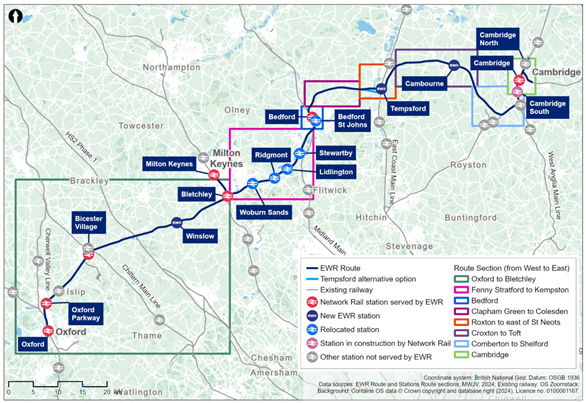Guide to East West Rail’s
consultation
This document highlights where to find information about updated proposals for East West Rail (EWR) – the proposed new rail link that would connect communities between Oxford, Milton Keynes, Bedford and Cambridge. Our proposals involve the construction of a new railway between Bedford and Cambridge, plus essential railway improvement works to upgrade the existing railway between Oxford and Bedford.
Listening to and understanding the views of people living and working in the communities EWR would serve is fundamental to the way this new rail connection will be designed, built and operated. We’re carrying out a non-statutory consultation for 10 weeks from 14 November 2024 to 24 January 2025 to share emerging plans and obtain feedback on the early designs, including areas where we are considering options.
We will take this feedback into account as we develop the designs in more detail and select preferred options, using your responses to review potential opportunities and inform plans to mitigate the impacts of the project. These will be considered alongside ongoing environmental, economic and technical studies to make sure we’re building the right railway for communities across the whole area between Oxford and Cambridge.
This is the third consultation on EWR (following on from our consultation on route options held in 2019 and route alignment options in 2021) and is an opportunity for us to obtain informed feedback from local communities and stakeholders on updated proposals for EWR. Each consultation gives people the chance to provide feedback to help shape our proposals as they progress.
We want to hear from local communities, businesses and people who work in the area, and people whose homes or properties could be affected by the proposals. We will carefully consider the feedback we receive as we continue to finalise plans for the railway.
This guide sets out how you can respond to the consultation and where to find more information about the proposals, including:
-
Where to find out more about the proposed route.
-
How to respond to the consultation.
-
What happens next.
If you or anyone you know would prefer this guide in a different format or language, please let us know by emailing [email protected] or calling us on 0330 134 0067.
The benefits of East West Rail
For more than 30 years, councillors and business leaders from across the region have been calling for a rail link connecting Oxford and Cambridge.
By making it easier, faster and more affordable to get around the region, the new railway will open up new journeys, cut travel times on public transport, ease congestion on local roads and bring more jobs within reach of people living locally.
The vibrant communities between Oxford, Milton Keynes, Bedford and Cambridge combine beautiful landscapes and a rich cultural heritage with world-famous centres of education, life sciences, technology and an increasingly dynamic business scene.
However, the lack of good east-west transport connections makes it harder for residents to make the most of everything the region has to offer. From faster commutes to days out with friends and family, EWR would make it easier to reach the things that matter most, bringing a range of benefits to communities between Oxford and Cambridge, and across the UK more broadly, including:
-
Easier access to other parts of the UK.
-
Fast, easy travel across the region for everyone.
-
More jobs within reach of local people.
-
Reliable public transport that will reduce congestion on local roads.
-
A greener way to travel around the region.
-
Opening up new areas for businesses to grow.
-
Expanding the labour market locally.
-
Attracting businesses into the region and investment into the country.
More information about the benefits of EWR can be found in Chapter 4 of the consultation document.
How East West Rail is being delivered
EWR is being promoted and brought into use in three connection stages.
-
Connection Stage 1 enables services to run between Oxford and Milton Keynes. The first part of this stage, the link between Oxford and Bicester, is already in place. The work to extend services further north and east to Bletchley and Milton Keynes was given planning consent in 2020 by an order made by the Secretary of State under the Transport and Works Act 1992.. Construction is well underway and passenger services will start running from 2025.
-
Connection Stage 2 work is ongoing to bring forward services between Oxford and Bedford from 2030. Planning consent for these works was also granted by the Transport and Works Act order in 2020.
-
Connection Stage 3 would complete East West Rail and enable passenger services to operate between Oxford and Cambridge via Bletchley and Bedford. To complete this work, we will need to apply for a Development Consent Order (DCO), which would grant consent to build the new railway between Bedford and Cambridge, as well as the other upgrades between Oxford and Bedford to deliver the full proposed EWR service.
Connectivity to Aylesbury remains a longer-term aspiration, but is not currently within the scope of EWR and is not included in the proposals set out in this public consultation.
The proposed new railway between Bedford and Cambridge and the associated work to upgrade the existing railway between Oxford and Bedford are referred to as ‘the project’ and are the subject of this non-statutory consultation.
More information about the three connection stages and consultation on Connection Stage 3 can be found in section 4.2 of the Consultation Document.
The consultation process
The proposed new railway between Bedford and Cambridge has been designated as a project of national significance. This means we will apply to the Secretary of State for Transport for a DCO, which would grant consent to build and operate the new railway between Bedford and Cambridge and the additional upgrades to the existing railway between Oxford and Bedford.
We are carrying out two rounds of consultation before applying for development consent: this non-statutory consultation and a statutory consultation that will be held in 2025. Carrying out two rounds of consultation will maximise the opportunity to gather people’s feedback and take this into account as we finalise our proposals for the railway.
Once we have completed all of our consultation and finalised our proposals, we will prepare and submit our DCO application to the Planning Inspectorate, which processes applications on behalf of the Secretary of State. Following the examination into the DCO application, the Planning Inspectorate will make a recommendation to the Secretary of State who will decide whether development consent should be granted.
More information about this consultation and the planning process for a DCO application can be found in Section 4.4 of the Consultation Document.
Figure 1: The DCO Process

Where to find more detail about proposals for East West Rail
We have published a range of consultation materials as part of this consultation, including:
-
The Consultation Document, which provides an overview of our proposals.
-
A Technical Report with more detailed information about our proposals and how they have been developed.
-
An Environmental Update Report that provides initial information about potential environmental effects.
-
A Transport Update Report with initial information about the potential transport impacts from the project.
-
Maps, plans and visualisations that show the proposed route alignment, the land that would be required for the project, and illustrations of what some of the main features of the railway could look like.
-
Factsheets with more information about key elements of the proposed railway.
-
A list of frequently asked questions (FAQs) that cover key queries about the consultation.
All of these materials are available on our consultation webpage at https://eastwestrail.co.uk/consultation
Where to find out more about the proposals in your area
To share our plans in specific areas along the route, we have split the route into eight sections.
Figure 2: Map showing the eight route sections

The chapters covering the eight route sections in the Consultation Document contain an overview of what we are proposing and why, how we have considered the environment, and more detailed information about the proposals for specific locations. The main proposals for each route section are summarised on the next pages.
Oxford to Bletchley – Chapter 8
This chapter covers updated proposals for the existing railway between Oxford and Bletchley. Proposals include:
-
Closing the level crossing at London Road in Bicester, and replacing it with either a bridge or underpass for pedestrians, cyclists and other users, with road traffic re-routed via existing and upgraded roads.
-
Potential upgrades at Oxford, Oxford Parkway, Bicester Village, Winslow, and Bletchley stations.
-
Passing loops at Islip and Middle Claydon so that faster passenger trains could overtake slower freight trains.
Fenny Stratford to Kempston – Chapter 9
This chapter covers updated proposals for improvements to the existing railway and stations between Fenny Stratford to Kempston, which forms part of the Marston Vale Line that runs from Bletchley to Bedford. Proposals include:
-
Two options for service patterns and stations on the Marston Vale Line. The options would either retain all nine existing stations or consolidate them into four new stations at Woburn Sands, Ridgmont, Lidlington and Stewartby.
- Twin-tracking at Fenny Stratford, where a second track would be built to allow for new EWR services.
- Our approach to level crossings on the Marston Vale Line, including diversions and closing some crossings.
- Passing loops between Ridgmont and Stewartby so that faster passenger trains could overtake slower trains.
Bedford – Chapter 10
This chapter shares updated proposals to the south of Bedford and Bedford St Johns, Bedford station and the area north of Bedford, including proposals to:
-
Relocate Bedford St Johns station to the west to better serve Bedford Hospital.
-
Build a new two-track railway to the north of Sandhurst Road that would replace the existing single track Marston Vale Line into Bedford station.
-
Rebuild the Bedford station building, creating a new station plaza, constructing footbridges and two new platforms (reduced from three shown in previous proposals), and providing replacement car parking.
-
Construct two additional tracks alongside the Midland Main Line to make sure EWR services can run reliably without conflicting with other trains.
-
Build a new 1.1km (0.68 miles) long viaduct over the Great River Ouse and Paula Radcliffe Way.
-
Realign Ampthill Road, Cauldwell Street, Ford End Road, Bromham Road and the A6 Great Ouse Way.
Clapham Green to Colesden – Chapter 12
This chapter highlights how proposals between Clapham Green and Colesden have been developed and ways we’ve sought to reduce their impact. This includes proposals to:
-
Lay approximately 12km (7 miles) of new railway track and build embankments, cuttings, bridges and viaducts where needed to enable this.
-
Divert some roads, tracks and paths that cross the new railway so that these can still be used, for example by building new bridges.
-
Install two passing loops so that faster passenger trains could overtake slower trains.
Roxton to east of St Neots – Chapter 13
This chapter shares updated proposals for the section of EWR that runs between Roxton and east of St Neots. Proposals include:
-
A section of new railway and associated infrastructure approximately 10km (6 miles) long.
-
Two possible alignments through the Tempsford area (1b and 1c), each making use of viaducts and embankments.
-
A new station at Tempsford, which would also include an interchange with the East Coast Main Line.
-
A temporary rail logistics hub connecting with the proposed alignment and the East Coast Main Line to enable construction materials to be transported by rail.
Croxton to Toft – Chapter 14
This chapter covers updated proposals for the section of new railway beginning at the roundabout east of St Neots, running north of Cambourne and the new dual carriageway to be known as the A421 and A428, before crossing the A428 and ending at the B1046 between Toft and Comberton. Proposals include:
-
Approximately 19km (12 miles) of new railway, including passing loops so that faster passenger trains could overtake slower trains.
-
A new station at Cambourne to improve connectivity into Cambridge for people living there and support the future growth of the town.
-
A cut and cover tunnel beneath the A428, the proposed Bourn Airfield development and Highfields Road, with associated temporary diversion of the A428 and other local roads.
-
New bridges for road, track and path crossings, bridges and culverts for watercourses and associated diversions where necessary.
Comberton to Shelford – Chapter 15
This chapter covers the section of the route running from the B1046 Comberton Road to Addenbrooke’s Road, Shelford. Proposals include:
-
New railway tracks between Comberton and Hauxton Junction east of the A10 Royston Road.
-
A tunnel, bridges and crossings for roads and footpaths including the A10 Royston Road diversion.
-
Options for maintaining connectivity between Harston and Newton after the closure of the Harston level crossing, including a potential new footbridge 400m east of the Harston level crossing.
-
A new road bridge and a potential new footbridge to replace the Hauxton Road level crossing.
-
River and stream crossings and two new viaducts over Bourn Brook to the south of Comberton and the River Rhee to the west of Harston.
Cambridge – Chapter 16
This chapter outlines proposed improvements to the existing railway and stations for the section of the route that would run from Addenbrooke’s Road bridge over the existing West Anglia Main Line, north of Great Shelford, to the A14 bridge north of Cambridge North station, and to Yarrow Road in Cherry Hinton to the East of Cambridge, on the Newmarket line. Proposals include:
-
Two new railway tracks next to the existing West Anglia Main Line.
-
A new bridge to replace Long Road overbridge, wide enough to accommodate the additional tracks.
-
A new platform, platform extensions, bridges, building upgrades and railway systems modifications at Cambridge station.
-
Safety improvements at the existing level crossing at Laundry Lane.
-
A new facility at Cherry Hinton allowing EWR passenger trains to turn around.
You can find more detailed information about the proposals for each of these route sections in the Consultation Document.
Route-wide considerations
The Consultation Document also includes a range of route-wide considerations, including how the railway will be delivered and operated. These topics are described in Chapters 5 and 6 in the Consultation Document.
-
Operating the railway – Chapter 5, covers proposals for powering the trains – including important updates on electrification – and other key issues like our approach to freight.
-
Delivering the railway – Chapter 6, includes information about our approach to the environment and sustainability, public rights of way and highways, homes, land and property and construction.
How to get involved
We are holding a series of in-person consultation events across the route. At each event you can review the updated proposals, talk to members of our team, ask questions and submit your feedback.
If you can't attend an event in person, our three online events will give you a chance to understand more about our proposals and ask questions.
To find out when a consultation event is happening near you, please visit https://eastwestrail.co.uk/consultation2024.
Printed consultation materials are available at information points along the route, including the Consultation Document, Technical Report, maps, drawings, plans, Environmental Update Report, Transport Update Report and factsheets. Feedback forms and freepost envelopes will also be available to take away. To find the information points, please visit https://eastwestrail.co.uk/consultation2024 or email us at [email protected].
How to respond to the public consultation
A feedback form, which contains questions about the proposals, is available in both paper and online versions for you to share your views.
You can respond to the consultation by:
-
Completing the consultation feedback form online at eastwestrail.co.uk/feedback.
-
Emailing a copy of the feedback form to [email protected].
-
Sending a copy of the feedback form to Freepost EAST WEST RAIL.
-
Handing in a copy of the feedback form at a consultation event.
For further information on materials in accessible formats or alternative languages, or to request a paper copy of the feedback form, please call us on 0330 134 0067, or email us at [email protected].
Please make sure you share your views with us before the closing date of 24 January 2025.
What happens next?
Following the non-statutory consultation and after taking account of what you say, we will hold a statutory consultation in 2025.
Once we have completed all of our consultation and finalised our proposals, we will submit our DCO application. More information about the DCO process can be found here https://eastwestrail.co.uk/consultation2024
Find out more
|
|
Visit our website |
You can find the full range of consultation material in accessible and downloadable formats. You’ll also find information on how you can respond to this consultation and further details about East West Rail.
|
|
|
Get in touch |
You can always get in touch with a member of our team by calling 0330 134 0067 or emailing [email protected] |


